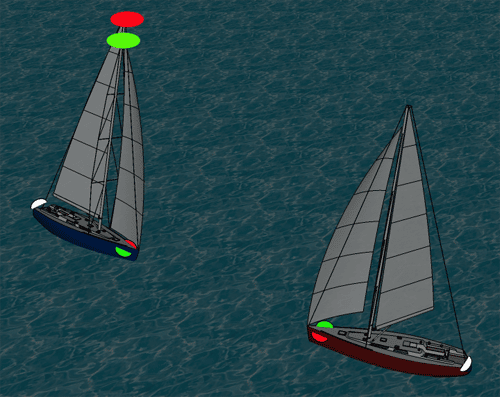Mast head light confusion
Here is a question from a Student who posted it on Disqus. I felt it was important enough to post out here for public. Displaying correct lights on boats is important.
QUESTION:
Could you please provide more of an explanation for the following:
Although ‘steaming light’ is used extensively, this does not have a definition within the IRPCS [International Regulations for Prevention of Collisions at Sea], the correct definition being a masthead light.
If the tri-colour light can replace the stern and red/green pulpit light on a sailboat how can it be unacceptable to use the tri-colour light with mast head light? If you are under power you of course need your steaming light/ mast head light illuminated. So if you don’t have pulpit or stern lights aboard as you are using a tri colour light how can you do this?
MY ANSWER:
Agreed – lights can be confusing at the onset. In this particular topic, sailors tend to get confused because they think a mast is only on a sailboat. But, a mast head light is also used (and defined for use) on power boats. Take a look at this image shown in the rules. It shows a power driven vessel longer than 50 meters using two mast head lights.

A large Power vessel displaying two mast head lights.
Here is the definition of a mast head light in the rules:
(a) “Masthead light” means a white light placed over the fore and aft centerline of the vessel showing an unbroken light over an arc of the horizon of 225 degrees and so fixed as to show the light from right ahead to 22.5 degrees abaft the beam on either side of the vessel.
Note also that is does not say the light must be at the top of the mast.
For sailboats, a tricolored light is a light described by rule 25(b) in USCG Nav Rules. It is at or near the top of the mast and is for sailing vessels less than 20 meters in length. It is an optional alternative to having the lights down on the hull or pulpits. It faces a white light to the aft 135 degrees plus red from directly forward around to port 112.5 degrees and a green light directly forward and around to starboard 112.5 degrees. This makes up 360 degrees and meets the requirement for a sailboat sailing. When the sailboat turns on it’s engines it must also in addition to the white, red and green above, display a white light 225 degrees facing forward. You can name this light what ever you like but it must exist. These white “mast head” lights are also defined by the distance they must be seen by – it does not mean they have to be at the top of the mast. On power vessels they are typically at the top of the mast because that is what the mast is for.
Here is a sailing vessel under sail only with a tricolored light

Tri-colored lights on a sailboat
On a sailboat less than 50 meters in length, a mast head light (white under power light) can be just “up the mast” anywhere. It’s not part of the tri color. It is white and faces forward 225 degrees and is to be used when the sailboat is under power. You also might be confusing the term mast head light with the two all around red and green lights at the top of the mast. These are not mast head lights. They can be used in addition to the hull or pulpit mounted red green and white. The rules prevent a top of the mast tricolored light AND the two all around red and green at the top of the mast. This would create confusion and may be your source of confusion. i.e it is unacceptable to use the tricolored and two all around red and green lights. Again the mast head is white 225 deg forward facing to be used under power only.
Here is a vessel with the two all around red and green lights.

The Vessel sailing “on starboard” is utilizing the optional two all around red and green lights.
Here are the rules as stated:
Rule 25 – Sailing Vessels Underway and Vessels Under Oars
(a) A sailing vessel underway shall exhibit:
(i) sidelights;
(ii) a stern light
(b) In a sailing vessel of less than 20 meters in length, the lights prescribed in Rule 25(a) may be combined in one lantern carried at or near the top of the mast where it can best be seen. [note this is the tricolored light]
(c) A sailing vessel underway may, in addition to the lights prescribed in Rule 25(a), exhibit at or near the top of the mast, where they can best be seen, two all-round lights in a vertical line, the upper being red and the lower green, but these lights shall not be exhibited in conjunction with the combined lantern permitted by Rule 25(b).
I hope that helps.
I highly recommend that you complete our Navigation Rules Course. It is free for everyone.

International Rules for Prevention of Collision at Sea FREE Sailing Course
We also have a Paper Book that you should order and keep on your boat for reference.
The book is a stand alone excellent explanation of the Rules of the Nautical road and is a good and quick easy read. It has additional really cool features. Through out the book you will see QR Codes. When you scan any QR code with your mobile device, the book element comes alive and shows you animations and videos.
To get a QR Reader –
Order the International Rules of Prevention of Collision at Sea Book from Amazon.
- RYA Day Skipper with NauticEd - April 1, 2024
- NauticEd uses the SailTies GPS Tracking App - March 29, 2024
- Sea of Cortez Flotilla – February 2025 - March 8, 2024



